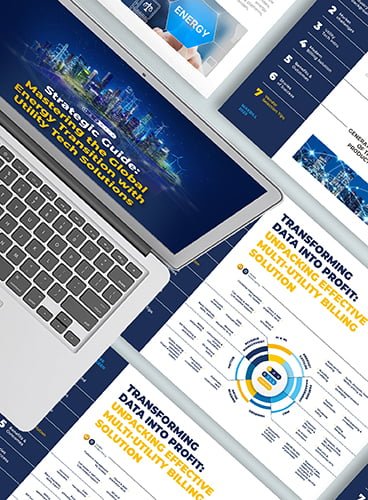Updated: April 16, 2025
Half-hourly meter readings are at the heart of the entire Market-Wide Half-Hourly Settlement (MHHS) reform. Suppliers must prove their systems can collect, process, and act on HH data as part of the qualification milestone (M14).
The recent CR055 by Ofgem delayed the date of milestone M14 by 7.5 months: from March 2026 to late October 2026. The rule still stands: fail to qualify by M14, and you’re not allowed to grow your customer base under MHHS.
Ofgem wants to ensure only fully compliant suppliers are allowed to scale in the new smart energy landscape. The reform is meant to protect consumers from being signed up by companies not ready for HH billing, data handling, or smart tariffs.
It also protects the market from errors or inefficiencies that could disrupt settlement.
In this article, you’ll get a ‘straight-to-the-point’ roadmap to comply with the MHHS rules, also covering in-house systems that get you qualified for key regulatory milestones. Let’s dive in.
Key Takeaways
- Suppliers that fail to qualify by the new deadline (M14) will be prohibited from acquiring new customers.
- There are 5 key time milestones (including the CR055 delays) highlighting what suppliers should do at each stage to stay compliant and competitive.
- To get ready as well as possible, suppliers should comply with the revised MHHS implementation timetable, allocate sufficient resources for testing and migration, engage early in the qualification process and support Ofgem’s 2025 regulatory package.
- Suppliers specifically need to get right in their billing, data handling, and customer onboarding to align with the Market-wide Half-Hourly Settlement (MHHS) requirements.
- MaxBill billing and meter reading management systems allow processing 48 half-hour data points per customer, per day. It supports time-of-use tariffs — e.g., off-peak discounts, dynamic pricing based on real grid conditions.
- MaxBill supports suppliers in onboarding of new customers onto MHHS-compatible meters (smart meters capable of half-hourly data reads).
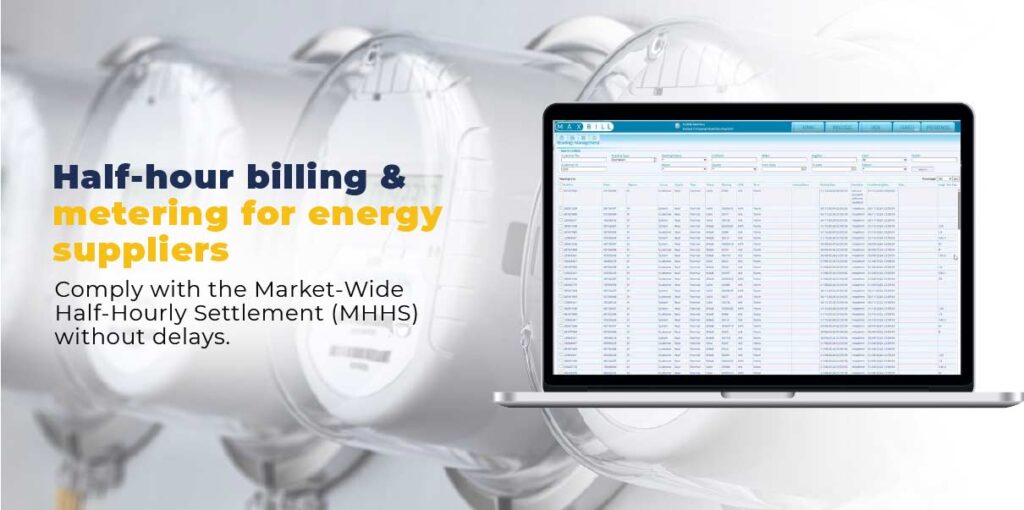
Why shifting to half-hourly meters and complying with the MHHS programe ?
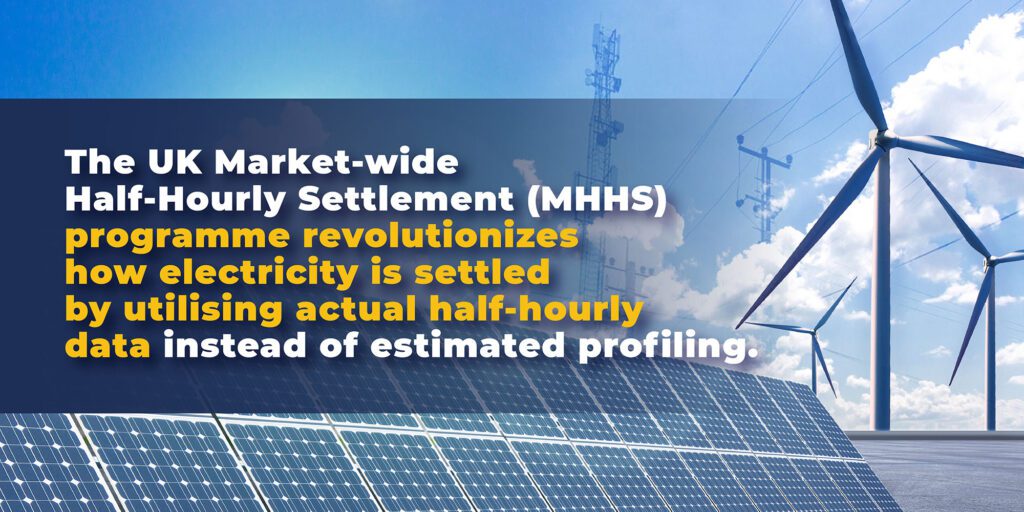
The UK’s electricity industry is undergoing a significant transformation with the implementation of the Market-wide Half-Hourly Settlement (MHHS) programme. This initiative aims to revolutionize how electricity is settled by utilising actual half-hourly data instead of estimated profiling.
This shift will decrease the settlement window from 14 months to four months, providing more accurate and timely data for both consumers and utilities.
Half-hourly meters are crucial to the MHHS programme because they provide the necessary granularity of data to enable more accurate settlements. They record electricity usage at half-hourly intervals, allowing for precise measurement and billing based on actual energy consumption rather than estimates.
This accuracy is essential for creating responsive tariffs and managing electricity demand more effectively.
Related:
Half-Hourly Settlement: Is Your Utility Business ‘Reform-Able’?
The advantages of half-hourly meters explained
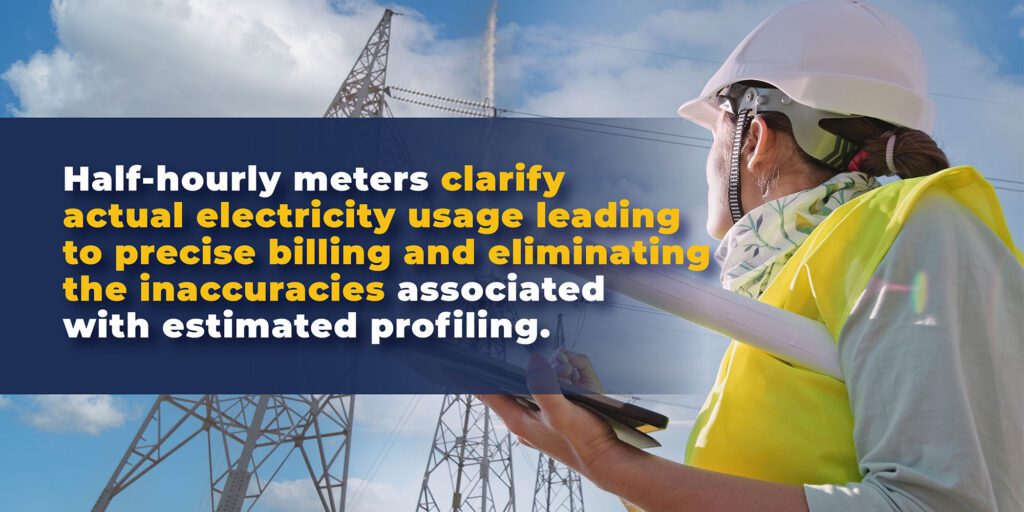
Accurate Billing: Half-hourly meters provide real-time data, which helps utility billing software calculate actual electricity usage. This eliminates the inaccuracies associated with estimated profiling.
Responsive Tariffs: The data from half-hourly meters enables the creation of truly reflective pricing models, such as time-of-use (ToU) tariffs. These tariffs can vary prices based on the actual cost of generation and demand, encouraging consumers to adjust their usage patterns to reduce costs and grid strain.
Demand Management: With accurate consumption data, utilities can better manage and balance electricity demand. This is particularly important as the UK transitions to more renewable energy sources, which can be intermittent and require flexible demand management.
Energy Efficiency: Consumers can gain insights into their electricity usage patterns, allowing them to make informed decisions about energy consumption and efficiency improvements.
Grid Optimisation: The precise data from half-hourly meters helps in optimizing the electricity grid, reducing the need for excess capacity and infrastructure investments. This is crucial given the forecasted increase in electricity demand due to electrification of transport and heating.
The risks of not qualifying by the new deadline of MHHS for energy suppliers
Key risks include:
- Regulatory risk: Suppliers that fail to qualify by the new deadline (M14) will be prohibited from acquiring new customers.
- Operational risk: Many suppliers underestimated the complexity of multi-party system integration testing (SIT), leading to delays and additional testing requirements.
- Resource constraints: There is evidence of insufficient staffing, poor test coordination, and limited contingency in the original plans, which could risk further delays.
- Reputational and financial risk: Delays increase implementation costs and postpone the consumer benefits, potentially affecting trust and competitiveness
Key time milestones of MHHS (incl. CR055 delays) and their breakdown
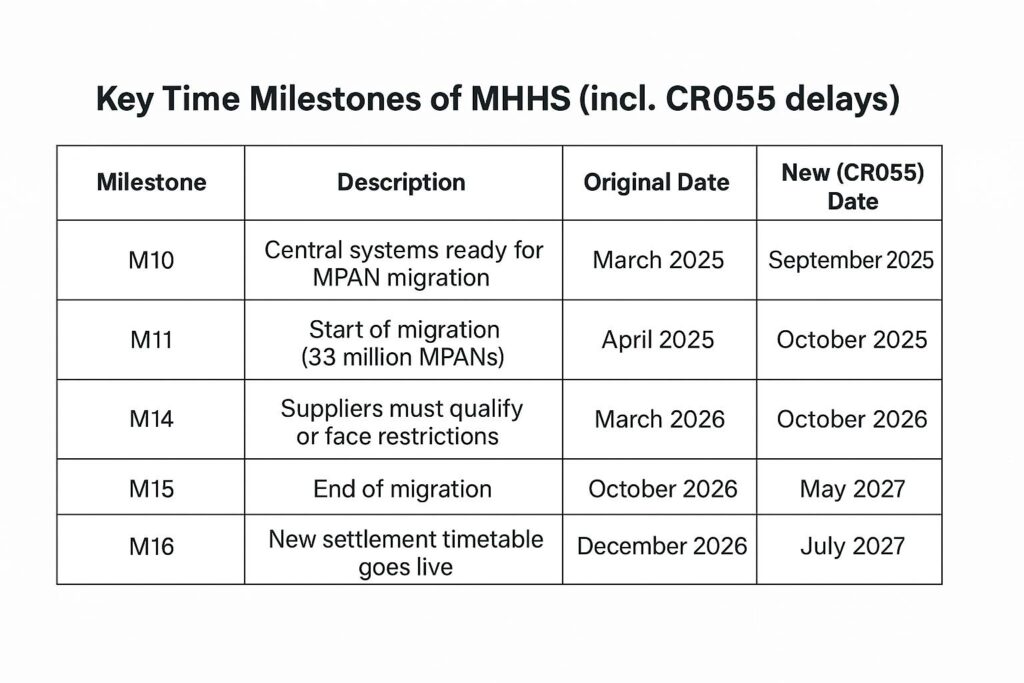
M10 – Central Systems Ready for MPAN Migration
This is the point when central market systems (BSC, DCC, registration services) are fully functional and ready to start migrating customers to the MHHS model.
M11 – Start of MPAN Migration
The actual migration of customers (33 million MPANs across GB) from legacy settlement to half-hourly settlement begins.
M14 – Supplier Qualification Deadline
Suppliers must fully qualify under MHHS by this date — or they will be barred from signing new customers.
M15 – End of Migration
All MPANs across the market must have been migrated to MHHS-based settlement.
M16 – New Settlement Timetable Goes Live
The new, faster settlement timetable becomes the industry standard — replacing old, slow reconciliation cycles.
How can energy suppliers be fully ready for half half-hourly meter readings transition?
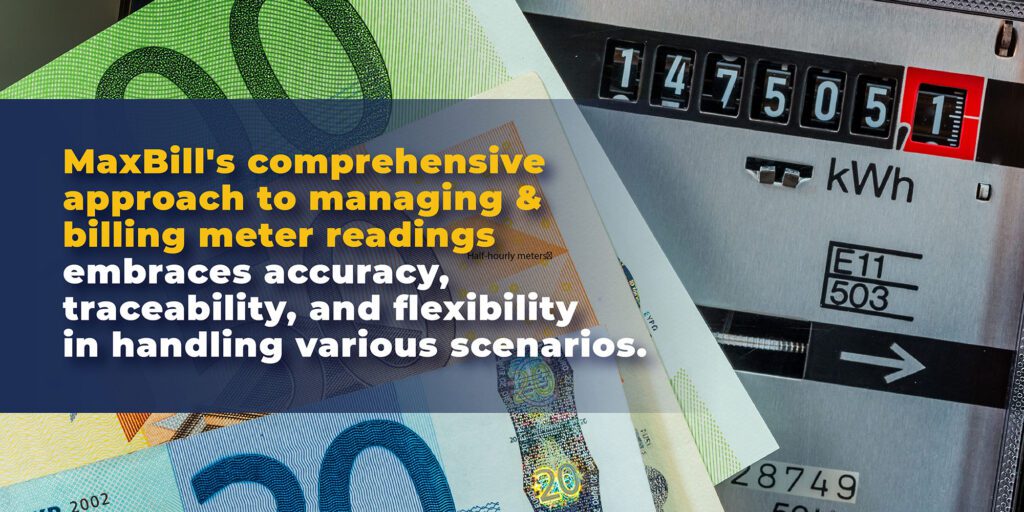
To prepare effectively, suppliers should:
- Comply with the revised MHHS Implementation Timetable, ensuring systems and staff are aligned to meet new milestone dates.
- Allocate sufficient resources for testing and migration, especially across multiple parties in the system.
- Engage early in the qualification process, which includes up to 14 months of testing and approvals.
- Support Ofgem’s regulatory package being introduced in early 2025, which may include:
- Mandatory reporting,
- Licence modifications,
- Performance targets for MPAN migration,
- Additional compliance obligations to avoid further delays.
- Mandatory reporting,
So, what should suppliers do?
- Prepare billing systems to fully reflect HH metering charges per customer segment.
- Educate customers on what these charges mean — and how they can reduce electricity costs by changing behaviour.
- Work with DCC and metering agents to ensure metering costs are managed efficiently across your portfolio.
- Incorporate these costs into your MHHS qualification and compliance processes.
Discover MaxBill metering and billing
Business energy suppliers – get ready!
Of course, the Market-Wide Half-Hourly Settlement (MHHS) regulation applies to business energy suppliers that serve energy intensive businesses (from microbusiness to large industrial/commercial (I&C) suppliers).
Historically, large businesses were already settled half-hourly (mandatory since 2017), but SMEs and microbusinesses often weren’t. Most of them didn’t have smart meters.
So, basically, under MHHS, they are obliged to qualify (by milestone M14, now due October 2026) to operate in the MHHS world — or face restrictions like being blocked from onboarding new customers.
So what must business energy suppliers do?
Basically, the same thing that domestic suppliers do, but at a greater scale. The process includes:
- Ensure all non-domestic Meter Point Administration Number (MPANs) are smart-enabled or migrated.
- Handle more complex contract types and billing logic to deliver transparent and accurate business electricity bills.
- Work closely with commercial clients to explain data sharing, tariff changes, and expected impacts.
Distribution network operators – get ready!
Under MHHS conditions, network charges and grid usage are settled based on real-time consumption. This is where DNOs come in. They have to:
- Integrate with the new half-hourly data flows,
- Support accurate registration and change of supplier processes,
- Enable faster access to smart meter data via DCC or other platforms,
- Handle new tariff and load profiling models based on actual usage, not static assumptions.
What are DNOs’ responsibilities under MHHS? They are involved in the reform’s execution, and thus are required to:
- Update their systems to be MHHS-compliant — this includes managing metering data flows, registration services, and connectivity with central settlement systems.
- Participate in Systems Integration Testing (SIT) — they are part of the “Minimum Viable Cohort” that must complete testing for go-live to proceed.
- Pass qualification for LDSOs (Licensed Distribution System Operators) — they must demonstrate that their systems don’t introduce risk into MHHS.
- Enable settlement accuracy — especially for unmetered supplies and smart-enabled network loads.
What happens if they lag behind?
- Failure to qualify or meet testing obligations could delay the whole programme.
- Ofgem has signalled that it may introduce licence modifications for LDSOs, including performance targets for MPAN migration and mandatory reporting.
- MHHS is linked to Ofgem’s broader network modernisation and digitalisation goals, so DNO performance here will be under scrutiny.
Helping energy suppliers align with HH billing, data handling, customer onboarding
Suppliers specifically need to get it right in their billing, data handling, and customer onboarding to align with the Market-wide Half-Hourly Settlement (MHHS) requirements.
HH billing that reflects real-time, half-hourly data
MaxBill billing and meter reading management systems allow processing 48 half-hour data points per customer, per day. It delivers automatic meter readings and supports time-of-use tariffs — e.g., off-peak discounts, and dynamic pricing based on real grid conditions.
Invoicing is based on actual consumption patterns, not profiles or averages. Plus, the whole module comes with reconciliation billing logic to handle settlement re-runs in case of corrected data (is needed).
To sum up, at MaxBill, we’ve got you covered with fast, data-heavy, and flexible billing engines for configurable pricing models, including business electricity bills.
Agile contract management for business energy suppliers
A few words about contracts. Billing and settlement purposes of business energy suppliers are way more complex. Helping B2B businesses to handle complex contract management has been the bread and butter for MaxBill for 2 decades now.
Here’s a short overview of what MaxBill offers to business energy suppliers:
- Agile contract lifecycle management
- Automated customer onboarding and contract setup
- Serving diverse customer segments (from microbusiness to large enterprise) using one platform
- Automated billing logic for complex tariffs
- Bulk contract operations at scale
- Full traceability across half-hourly settlement data, reconciliations, and consumption variations
- Compliance with industry rules (e.g., MHHS, network charges, CfDs, RO schemes)
- Support for multiple billing cycles and contractual service-level agreements (SLAs).
Fast, secure, and standardised data handling
MaxBill ensures robust data management, including a seamless exchange of consumption data between suppliers, DCC, BSC systems, and service providers. It also ensures that customers’ half-hourly usage data is only used appropriately by complying with Data Access and Privacy Frameworks.
To help avoid delays or market errors, we offer automated data validation and correction processes. If needed, clear audit trails can be initiated to track data lineage for dispute resolution and compliance.
Customer onboarding ready for time-of-use world
MaxBill supports suppliers in onboarding new customers onto MHHS-compatible meters (smart meters capable of half-hourly data reads). Customers choose or are defaulted into suitable tariffs (e.g., time-of-use or dynamic tariffs).
To make the transition smooth for both, suppliers and customers can communicate via a MaxBill self-care portal where customers are being informed how their usage impacts cost under MHHS.
Consent mechanisms are part of the game. MaxBill makes sure the half-hourly data sharing is in place and trackable. Customers can review their consent inside the very self-service portal to avoid any customer confusion.
At the end of the day, MaxBill helps suppliers to achieve a level where onboarding flows are digital, informed, and compliant with consent policies.
Are you interested in getting ready for the MHHS reform with MaxBill? Let us know about your needs.

Related:
Smart Meter in Europe 2024-2030 to Transform Utilities and Empower Consumers.
What Is Net Metering, and How Does It Work?
What is Utility Submetering? How Does It Work?
Smart ways to optimise heat network metering revenue collection under regulatory pressures.
Half-hourly meter readings FAQ
What is the Market-wide Half-Hourly Settlement (MHHS)?
The Market-wide Half-Hourly Settlement (MHHS) is the UK nationwide regulation by Ofgem that applies to all licensed electricity suppliers in Great Britain. Its purpose is to ensure that every electricity consumer’s usage is settled using actual half-hourly data, regardless of size or sector.
The reform has time milestones that define the readiness of each organisation to be qualified as compliant with MHHS reform. In case of missing deadlines, energy suppliers are banned from signing up new customers, which leads to reputation damage and other negative ramifications.
How can energy suppliers get ready for the MHHS regulation?
To get ready for the MHHS regulation, the UK energy suppliers should start the qualification process as soon as possible, since the deadline is October 2026. Other preparation steps include compliance with the revised MHHS implementation timetable, allocation of sufficient resources for testing and migration, preparing billing and metering systems, and educating customers.
What is the best metering and billing system to comply with the Market-wide Half-Hourly Settlement (MHHS)?
The best metering and billing system is the MaxBill half-hourly billing and meter reading management solution that covers all the spectrum of metering and billing requirements needed to comply with the MHHS regulation.
